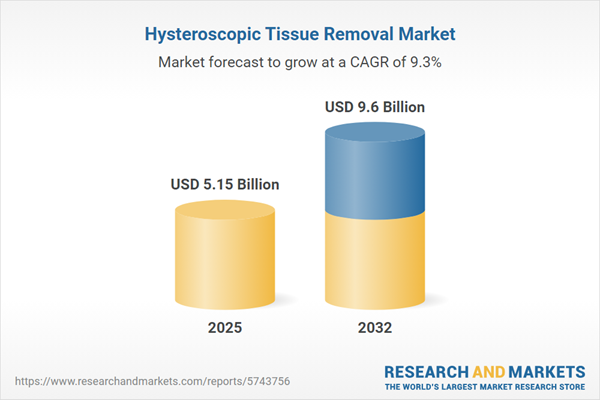Speak directly to the analyst to clarify any post sales queries you may have.
The hysteroscopic tissue removal market is undergoing rapid transformation as minimally invasive advancements shape gynecological care worldwide. Senior executives will find this report essential for identifying growth opportunities, technology adoption trends, regulatory shifts, and competitive dynamics reshaping the sector.
Market Snapshot: Hysteroscopic Tissue Removal Industry in Focus
The Hysteroscopic Tissue Removal Market grew from USD 4.71 billion in 2024 to USD 5.15 billion in 2025. It is expected to continue growing at a CAGR of 9.29%, reaching USD 9.60 billion by 2032. This upward trend reflects ongoing investment in device innovation, clinical integration, and the emergence of outpatient care models in North America, EMEA, and Asia-Pacific. Clinical leaders and administrators are prioritizing systems and solutions that blend precision excision with operational efficiency.
Scope and Segmentation of the Hysteroscopic Tissue Removal Market
This report analyzes the multifaceted landscape of the hysteroscopic tissue removal ecosystem:
- End Users: Ambulatory surgical centers, clinics, hospitals
- Distribution Channels: Direct sales, indirect sales (retailers, wholesalers)
- Product Types: Mechanical tissue removal systems, reciprocating morcellators, rotary morcellators (reusable systems, single-use systems), resectoscope systems
- Applications: Myomectomy, polypectomy, retained products of conception
- Components: Accessory modules, consoles, handpieces
- Regions: Americas (North America: United States, Canada, Mexico; Latin America: Brazil, Argentina, Chile, Colombia, Peru), Europe, Middle East & Africa (Europe: United Kingdom, Germany, France, Russia, Italy, Spain, Netherlands, Sweden, Poland, Switzerland; Middle East: United Arab Emirates, Saudi Arabia, Qatar, Turkey, Israel; Africa: South Africa, Nigeria, Egypt, Kenya), Asia-Pacific (China, India, Japan, Australia, South Korea, Indonesia, Thailand, Malaysia, Singapore, Taiwan)
- Key Players: Hologic, Inc., Medtronic plc, Olympus Corporation, KARL STORZ SE & Co. KG, CooperSurgical, Inc., Smith & Nephew plc, Richard Wolf GmbH, Johnson & Johnson, Boston Scientific Corporation, FUJIFILM Holdings Corporation
Key Takeaways for Senior Decision-Makers
- Minimally invasive hysteroscopic tissue removal is redefining gynecological treatment, driving widespread adoption in clinics and ambulatory settings.
- Technological progress in morcellation systems has enhanced visibility, precision, and workflow efficiency for clinicians dealing with intrauterine pathologies.
- Single-use device innovation is addressing sterility and infection control concerns, particularly within high-throughput outpatient environments.
- Integrative solutions—pairing ergonomic design with advanced imaging—are aligning with the growth of multidisciplinary and fertility-preserving care pathways.
- Collaboration among manufacturers, supply chain partners, and digital health firms is deepening, fueling advances such as remote monitoring, predictive maintenance, and data-driven service improvements.
- Leading industry players are expanding their portfolio through targeted R&D investment, partnerships, and strategic market coverage.
Tariff Impact: Navigating Regulatory and Supply Chain Changes
Targeted US tariff adjustments expected in 2025 are set to alter cost structures for tissue removal systems and consumables. Manufacturers are optimizing sourcing, localizing assembly processes, and establishing regional supplier alliances to preserve margins. These shifts influence procurement cycles within hospitals and ambulatory centers, compelling providers to evaluate total cost of ownership and service value beyond unit prices. Proactive distribution and flexible supply strategies are critical to ensure uninterrupted access and predictable costs for essential hysteroscopic devices.
Methodology & Data Sources
This report integrates qualitative insights from primary interviews with gynecologic surgeons, procurement managers, and healthcare administrators across global markets. Data validation was achieved through rigorous secondary research drawing from regulatory filings, literature reviews, and corporate disclosures. Multi-source data triangulation and cross-functional stakeholder reviews ensured accuracy and strategic relevance throughout the analytical process.
Why This Report Matters
- Informs investment and clinical priorities with actionable intelligence on technology trends, regional adoption, and evolving procurement strategies.
- Supports executive decision-making by clarifying the impact of regulatory changes, emerging competitive dynamics, and device innovation in the minimally invasive surgical space.
- Enables leaders to anticipate future challenges and harness opportunities by aligning operational strategies with patient-centric and value-driven care models.
Conclusion
The hysteroscopic tissue removal market is positioned for continued advancement as new technologies and care models redefine surgical efficiency and outcomes. Stakeholders prepared to embrace innovation, agile supply operations, and strategic partnerships will be best poised to shape the future of women’s health in this dynamic sector.
Additional Product Information:
- Purchase of this report includes 1 year online access with quarterly updates.
- This report can be updated on request. Please contact our Customer Experience team using the Ask a Question widget on our website.
Table of Contents
3. Executive Summary
4. Market Overview
7. Cumulative Impact of Artificial Intelligence 2025
Companies Mentioned
The companies profiled in this Hysteroscopic Tissue Removal market report include:- Hologic, Inc.
- Medtronic plc
- Olympus Corporation
- KARL STORZ SE & Co. KG
- CooperSurgical, Inc.
- Smith & Nephew plc
- Richard Wolf GmbH
- Johnson & Johnson
- Boston Scientific Corporation
- FUJIFILM Holdings Corporation
Table Information
| Report Attribute | Details |
|---|---|
| No. of Pages | 199 |
| Published | October 2025 |
| Forecast Period | 2025 - 2032 |
| Estimated Market Value ( USD | $ 5.15 Billion |
| Forecasted Market Value ( USD | $ 9.6 Billion |
| Compound Annual Growth Rate | 9.2% |
| Regions Covered | Global |
| No. of Companies Mentioned | 11 |









